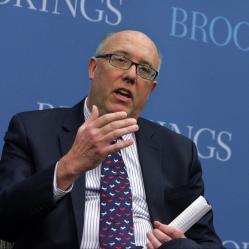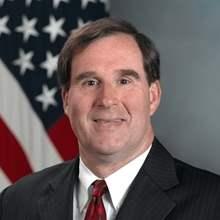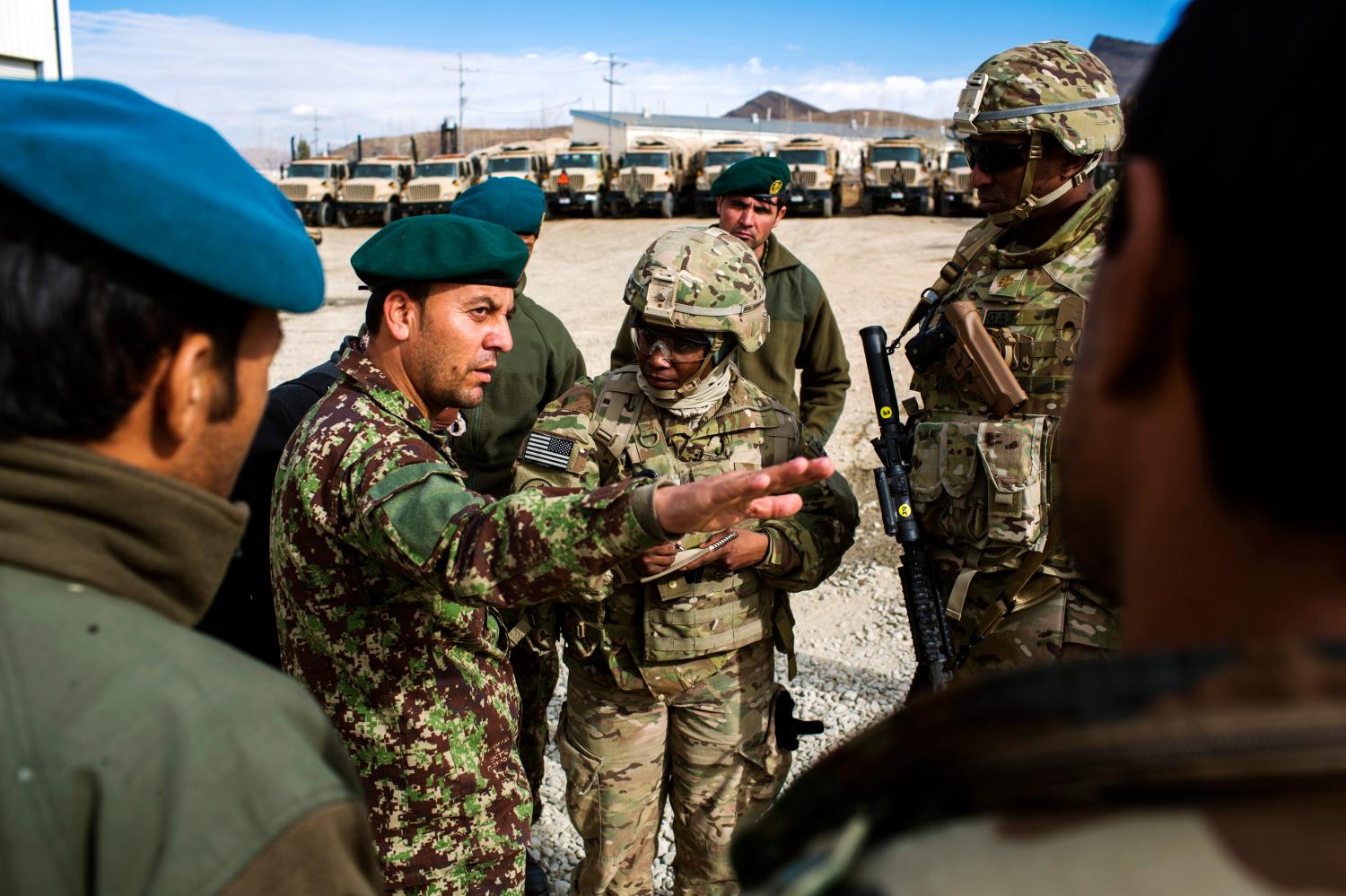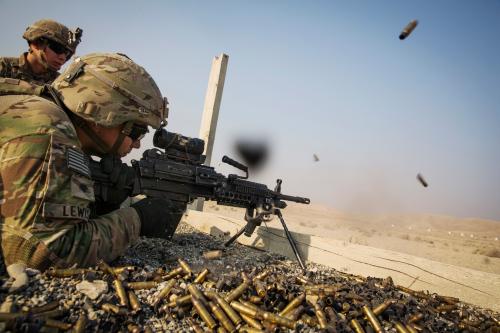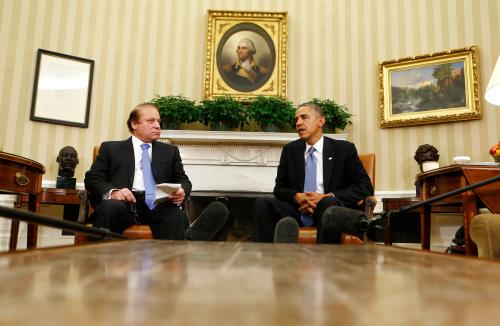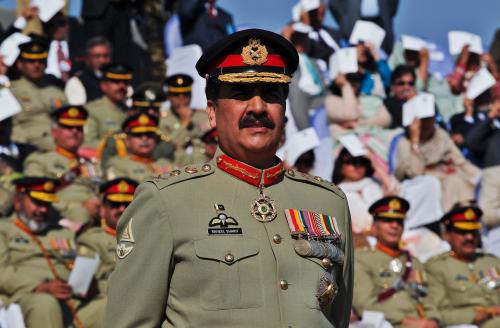The following brief is part of Brookings Big Ideas for America—an institution-wide initiative in which Brookings scholars have identified the biggest issues facing the country and provide ideas for how to address them—and is excerpted from a longer essay, published by the same group in September 2016 in The National Interest. (Updated January 26, 2017)
 The Obama years have encompassed an intense, challenging period in Afghanistan policy. The U.S. role in the war in that country, dating back to 2001, has cost more than 2,300 American lives and $800 billion in American resources, most over the last eight years. We mourn the dead and wounded and grieve for their families, and profoundly cherish their service to the nation. The mission has demanded enormous military, diplomatic and economic attention and investment. The numerous complexities were made more challenging by difficult relations with former Afghan leader President Hamid Karzai during his latter years in office, from an unsettled Afghan political environment more generally, from the legacy of disintegration of an Afghan state that had historically never been strong, and from the dual role of Pakistan—part friend, part strategic challenge in the conflict.
The Obama years have encompassed an intense, challenging period in Afghanistan policy. The U.S. role in the war in that country, dating back to 2001, has cost more than 2,300 American lives and $800 billion in American resources, most over the last eight years. We mourn the dead and wounded and grieve for their families, and profoundly cherish their service to the nation. The mission has demanded enormous military, diplomatic and economic attention and investment. The numerous complexities were made more challenging by difficult relations with former Afghan leader President Hamid Karzai during his latter years in office, from an unsettled Afghan political environment more generally, from the legacy of disintegration of an Afghan state that had historically never been strong, and from the dual role of Pakistan—part friend, part strategic challenge in the conflict.
President Obama has attempted to use the prospect of possible American/NATO withdrawal from the country to induce Afghan reforms and an Afghan sense of self-reliance. But ultimately, while progress has been achieved, he concluded that he cannot end the U.S. role in Afghanistan and that he would have to hand off an ongoing mission to his successor. Fortunately, that U.S. role today is much more modest than before—less than 10 percent of earlier American troop levels, less than 20 percent of earlier financial costs, and less than 5 percent of earlier U.S. casualty rates, as of this writing late in 2016.
The next American president will have an opportunity to settle Afghan policy onto a more durable, more effective, and less demanding course. In our view, the watchword for this new approach should be one of an enduring partnership, based on mutual commitment. We should plan for a long-term American—and coalition—role in the country that avoids the recent pattern of nearly annual reassessments of whether the United States should stay, militarily and as a major donor. We should also avoid publicly announced withdrawal timelines. Instead, we should take a quieter and more patient approach, consistent with the commitments the international community made at Bonn in 2011 to help make the entire 2015-2024 period the “decade of transformation” in Afghanistan. The U.S.-Afghan partnership should be recognized as generational in duration, given the nature of the threat and the likely longevity of its future manifestations. Less attention should be placed on troop numbers, and troop caps, as the barometer of whether an exit strategy is being successfully implemented. Rather, the emphasis should be on securing Afghanistan as a crucial pillar of America’s global anti-terror campaign and as a needed contributor to stability in the region.
The U.S. and broader international commitment should not, however, be unconditional. Indeed, the notion of conditional engagement was agreed between donors and the Afghan government in the Tokyo Mutual Accountability Framework of 2012 and remains valid today. If the enormous investment that the world has made in Afghanistan since 2001 is to be worthy of continuation, Afghans must do their part to improve governance and economic well-being, and thereby build public support for the government. The very enormity of that U.S. investment to date, and the value of Afghanistan in the broader struggle against jihadi extremism, argue strongly for trying to sustain—and build on—the progress we have collectively achieved so far. And while there is no easy answer about how to improve U.S. relations with Pakistan, we expect that clear articulation of an enduring American commitment to Afghanistan and the region can only help in gradually reducing the distrust and rivalry that often predominate in the relationships in Central and South Asia today.
The Path Ahead
It is not our purpose here to recommend a detailed way forward for the United States in 2017 and beyond. President Trump and his advisers will have to carry out that task, after first wrestling with the big strategic questions we discuss above and taking stock of actual conditions as they present themselves in the region next year. We would only wish to identify several of the lines of analysis and inquiry that any such review should squarely address:
Is a U.S. troop presence of some 8,500 Americans, as now planned, adequate? What strategy should guide their deployment? What force mix is most appropriate? We would counsel less attention to numbers, and less public emphasis on the size of the American troop presence as the central metric in evaluating the success or failure of U.S. policy in Afghanistan. The stability of Afghanistan and our ability to keep pressure on extremists in the region matter more than continual progress towards a smaller international military presence. But that said, it is worth noting that three years ago, U.S. commanders developed an option requiring 5,000 more foreign troops, and more intelligence capabilities, than are now envisioned. That larger posture, in conjunction with other NATO forces, would have provided the ability to work with each of Afghanistan’s six major Army corps throughout the country, while also providing counterterrorism and intelligence and training capabilities. Some of the deterioration in the Afghan security environment in recent times can be directly traced to the absence of these U.S./NATO capabilities—though Afghan leaders themselves must accept their fair share of the blame.
Is U.S./NATO airpower being used intensively enough? President Obama gave authorities to commanders to target ISIL in 2016. He subsequently gave authorities to expand certain operations against the Taliban as well. But since the Afghan air force is not likely to be fully built for some years, there is a case for further reassessment. It will be important to ask if the relaxation of rules of engagement that President Obama provided to American/NATO forces in Afghanistan in 2016 should go further, allowing even more substantial use of their airpower against the Taliban.
How should Washington try to engage Afghan politics? Political and diplomatic efforts in Afghanistan today are focused on managing immediate crises, of which there is never any shortage. It would be highly desirable to change this dynamic. Indeed, given the daunting challenges, the United States can be flexible about how the future government is structured, and about when already overdue parliamentary and district council elections will be held, as long as such decisions reflect general agreement among Afghan political leaders including President Ghani and Chief Executive Abdullah. Political processes in general should comport with the Afghan constitution and with the goal of achieving as much reasonable political consensus as possible. (In this context, it is worth noting that the Afghan constitution allows only two terms per person over a lifetime.) The United States should help Afghans remain politically united and improve governance, while remaining alert that some there would likely seek to manipulate us for their own purposes. For the longer term, we should engage constructive groups across Afghan society and encourage them to find ways to press for deeper political reforms.
Can development assistance be better focused? Ongoing U.S. development assistance levels of about $1 billion a year (in addition to the $4 billion annually that the United States is still providing to support Afghan security forces) are complemented by comparable aggregate donations from other governments, multilateral development banks, the United Nations, and select NGOs. It is very important to continue the long, hard task of improving accountability and efficiency in dispersing assistance and reducing corruption, while improving the delivery of government services. That means, in part, channeling more funds through the national government while carefully monitoring their use, so as to improve public finance. Ideas like strengthening the role of the U.N. Special Representative to coordinate the aid flows in partnership with the Afghan government are worth examining. And predatory corruption in particular needs to be targeted—blatant theft of large sums of funds from the public purse.
How should the United States adjust its Pakistan policy? Washington and Islamabad have common interests in many areas. Moreover, it is critical that this nuclear-armed country of 200 million remain stable. We wish to see a Pakistan that is at peace with its neighbors, peaceful internally, and economically thriving. Sustaining operations in Afghanistan without Pakistani ground lines of communication, while possible, would be very difficult and costly. These considerations argue strongly for cooperation.
However, it is clear that the course of action we have pursued since the early 2000s has not produced the needed changes in Pakistan’s policies in Afghanistan. Pakistan tolerates and in some cases supports the forces that target and kill U.S. military and civilian personnel, other foreigners, and many Afghans. The Taliban have safe havens within parts of Pakistan and access there to funds and equipment. The United States needs to oppose Pakistan’s role in these dynamics at every turn. In its dealings with Islamabad, Washington should prioritize these issues even more than on requesting Pakistan’s help with peace talks between the Afghan government and the Taliban.
Some believe that Pakistanis tolerate the Taliban out of conviction that America will again desert them—just as it did in 1989. But the United States has already stayed in Afghanistan 15 years this time, with no plans to leave. Under our proposal it would envision staying in the region a good deal longer. This is desirable, and it should help allay Pakistani fears that it will again face an Afghanistan in chaos or an Afghanistan dominated by its rival, India. Our purpose should be to change Pakistan’s calculus over time, while recognizing that whatever policies we adopt, Islamabad will likely not change its Afghanistan policy quickly (even if civilian leaders in Pakistan decide they favor that outcome).
This serious situation calls for a fundamental review of available options by the next U.S. administration. Without advocating these as a group, we would suggest serious consideration of some or all of the below (though some of us are more wary of the last two options):
- The United States could take further steps to pressure Taliban sanctuaries within Pakistan (with or without the support of Islamabad). The May 2016 killing of Mullah Mansour, the head of the Afghan Taliban, while he was traveling through southwestern Pakistan indicates the kind of direct action against the Taliban and Haqqani Network that could make an important difference.
- The Obama administration and Congress have already reduced Coalition Support Funds to Pakistan in recent years, and curtailed the use of Foreign Military Financing as well. But even today’s reduced amounts of U.S. assistance could be cut further. If Pakistan’s role in Afghanistan does not improve, in fact, the U.S. Congress will likely see to that, whatever President Trump may wish.
- Targeted economic sanctions could be selectively applied against certain specific organizations and individuals; Washington could encourage other countries to consider similar steps.
- Pakistan could even be designated as a state sponsor of terrorism, a finding that would not only be embarrassing to the country but also harmful to its economic prospects, given the likely influence on potential investors.
In more positive terms, Washington might also sketch out a vision of an improved relationship with Pakistan if Islamabad would show more forthright and consistent support for the goals of NATO in Afghanistan. This outcome would be highly desirable for broader American interests, given Pakistan’s central role in the stability of the entire region—and its ability to upend that stability. Washington should underscore that it could only be realized after Pakistan had verifiably acted to end its policies of sanctuary and support for the insurgents.
CONCLUSION
The situation in Afghanistan today is difficult. But it may not be measurably worse than one might have projected back in 2012 or 2013, when the Taliban resistance had already proven itself resilient in the wake of a NATO troop surge, and when elections loomed in Afghanistan as President Karzai’s second term in office neared its end. Compared with that benchmark, and in light of the fact that NATO withdrew 125,000 of the world’s best soldiers over the last five years and then circumscribed the role of U.S./NATO airpower, some deterioration was to be expected. The situation also remains considerably improved, in terms of the economy and human rights and human welfare, from what it was before—not only in the 1980s and 1990s but even in the early years after the overthrow of the Taliban. Since then, life expectancy has increased at least 10 years, child mortality has been cut at least in half, several million more children including millions of girls are in school, GDP per capita has more than doubled, a ring road has been completed (even if security conditions along it are not consistently as good as they should be), and many millions of Afghans have unprecedented access to cellphones, Internet, and media. And the United States has a coalition of international partners willing to stay the course with it.
While dangers are always present, new possibilities lie ahead. Determined collaboration between the White House and Congress as well as Afghan leaders can break the cycle of yearly approaches to the brink of the policymaking cliff. That can in turn help create a longer time horizon for security, political, and economic reforms that will surely take an additional decade or more even to reach a modest degree of success. In light of the continued extremist threat in Central and South Asia, and thus the importance of Afghanistan to western security, this is a burden that we can afford to bear—and one to which we should mutually commit in partnership with the Afghan people and government.

